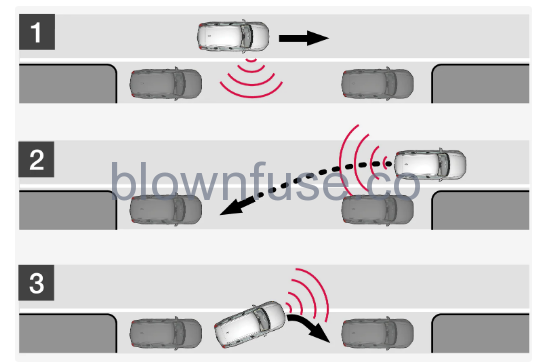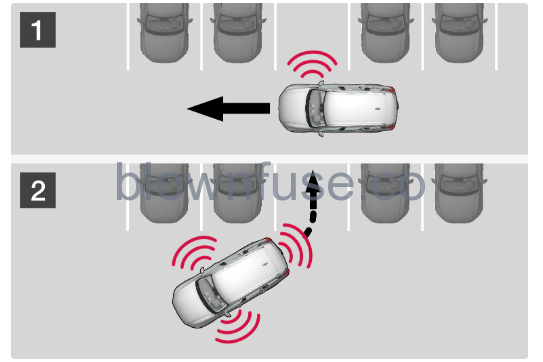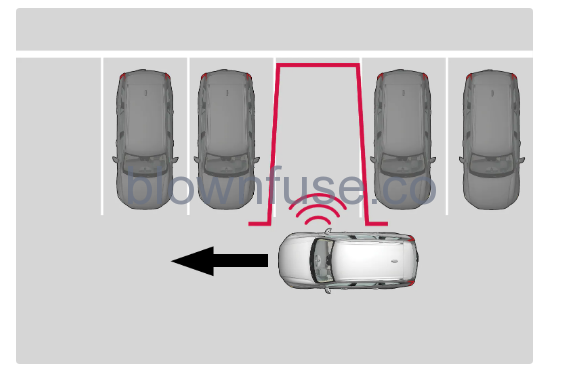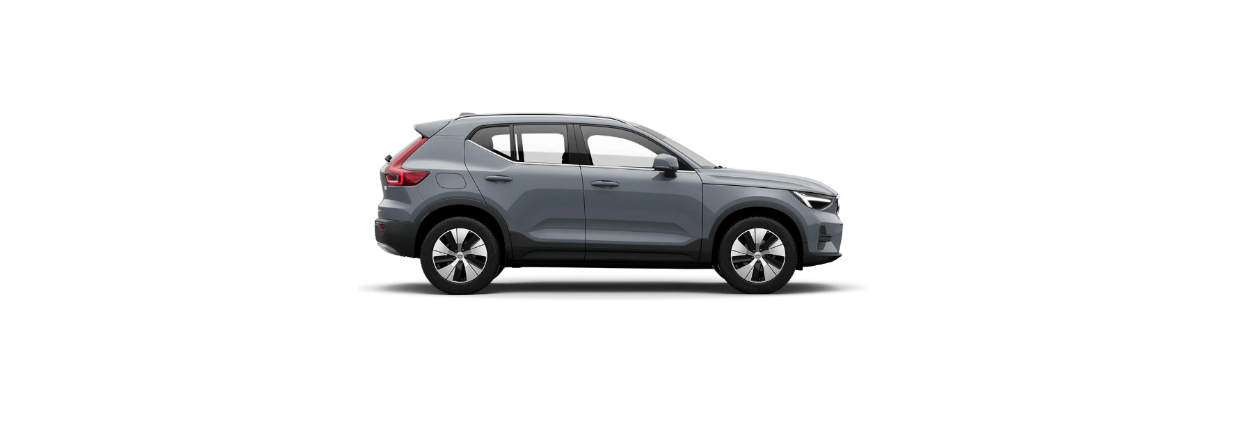2023 Volvo XC40 Active Park Assist

Park Assist Pilot (Option/accessory)
The function first checks if a space is large enough and if so then assists the driver to steer the car into the space. The center display indicates with symbols, graphics, and text the various operations to be carried out and when to do so.
- The function is supplementary driver support intended to facilitate driving and make it safer – it cannot handle all situations in all traffic, weather, and road conditions.
- The driver is advised to read all sections in the Owner’s Manual that relate to this function to learn about factors such as its limitations and what the driver should be aware of before using the system.
- Driver support functions are not a substitute for the driver’s attention and judgment. The driver is always responsible for ensuring the car is driven in a safe manner, at the appropriate speed, with an appropriate distance to other vehicles, and in accordance with current traffic rules and regulations.
Parking variants with Park Assist Pilot
Parallel parking

The principle of parallel parking.
The function parks the car using the following steps:
- A parking space is identified and measured.
- The car is reversed into space.
- The car is positioned in the space by means of driving forward/backward.
With the Park Out function, a parallel-parked car can also get help from the function with leaving the parking space.
Perpendicular parking

Principle for perpendicular parking.
The function parks the car using the following steps:
- A parking space is identified and measured.
- The car is reversed into the space and then positioned in the space by means of driving forward/backward.
When leaving a parking space, the Park Out function must only be used for a parallel-parked car – it does not work for a perpendicular-parked car.
Using Park Assist Pilot (Option/accessory)
This function measures space and steers the car – the driver’s job is to:
- keep an eye on what is happening around the car
- follow the instructions in the center display
- select a gear (reverse/forward) – an acoustic signal indicates when the driver should change gear
- regulate and maintain a safe speed
- brake and stop.
Symbols, graphics, and/or text appear on the center display when the different steps are to be performed.
The function can be activated if the following criteria are met once the engine has been started:
- No trailer is attached to the car
- Speed is lower than 30 km/h (20 mph).
The distance between the car and parking spaces should be 0.5–1.5 meters (1.6–5.0 ft) while the function is searching for a parking space.
Parking with Park Assist Pilot
The function parks the car using the following steps:
- A parking space is identified and measured.
- The car is reversed into the space.
- The car is positioned into the space – the system may then request that the driver changes gear and brakes.
Find and measure parking spaces
The function can be activated in the center display’s function view.
It can also be accessed from the camera views.
- Illuminated button – the function is activated.
- Extinguished button – the function is deactivated.
 Principle for searching before parallel parking.
Principle for searching before parallel parking.

Principle for searching before perpendicular parking.
Drive at a maximum of 30 km/h (20 mph) before parking.
- Tap on the Park In button in the function view or in the camera view.
- The function searches for a parking space and checks whether it is big enough.
- Be prepared to stop the car when the graphic and message on the center display state that a suitable parking space has been found.
- A pop-up window is shown.
- Select Parallel parking or Perpendicular parking and select reverse gear.
The function searches the area for parking, displays instructions, and guides the car in on its passenger side. But if required the car can also be parked on the driver’s side of the street:
- Activate the direction indicator to the driver’s side – then the system searches for a parking space on that side of the car instead.
Reversing into the parking space
 Principle for reversing into parallel parking.
Principle for reversing into parallel parking.

Principle for reversing into perpendicular parking.
- Check that the area behind the car is clear, then engage reverse gear.
- Reverse slowly and carefully without touching the steering wheel – and no faster than 7 km/h (4 mph).
- Be prepared to stop the car when instructed by the graphic and message on the center display.
- Keep your hands away from the steering wheel when the function is activated.
- Make sure that the steering wheel is not hindered in any way and can rotate freely.
- To achieve optimum results – wait until the steering wheel is fully turned before starting to drive backward/forward.
Positioning the car in the parking space
 Principle for positioning during parallel parking.
Principle for positioning during parallel parking.
Principle for positioning during perpendicular parking.
- Move the gear selector to the gear position as instructed by the system, wait until the steering wheel has been turned, and drive forward slowly.
- Be prepared to stop the car when instructed by the graphic and message on the center display.
- Select reverse gear and drive slowly backward.
- Be prepared to break the car when instructed by the graphic and message on the center display.
The function is deactivated automatically and the graphics and message show that parking is complete. It may be necessary for the driver to correct the car’s position. Only the driver can determine whether the car is properly parked.
The warning distance is shorter when the sensors are used by Park Assist Pilot (PAP) compared with when Park Assist System uses the sensors.
Auto-brake during parking sequence
If the parking sensors detect a vehicle or pedestrian within the intended route in front of or behind the car during a parking maneuver, the car is auto-braked to stationary.
The driver display then shows a pop-up message where the driver can choose to cancel the parking maneuver by tapping on Cancel, or tap Resume to continue the parking sequence.
Proceed as follows after selecting Resume:
- Check that there is free space around the car and follow the instructions in the center display, such as:
To continue – Gently accelerate away from the object.
Leaving parallel parking with Park Assist Pilot (Option/accessory)
When leaving a parking space, the Park Out function must only be used for a parallel-parked car – it does not work for a perpendicular-parked car.
The Park Out function is activated in the center display’s function view or in the camera view.
- Illuminated button – the function is activated.
- Extinguished button – the function is deactivated.
- Tap on the Park Out button in the function view or in the camera view.
- Use the direction indicator to select the direction in which the car should leave the parking space.
- Be prepared to stop the car when instructed by the graphic and message on the center display – follow the instructions in the same way as for the parking procedure.
Note the steering wheel can “spring” back when the function is completed – the driver may then need to turn the steering wheel back to the maximum steering angle in order to leave the parking space. If the function considers that the driver can leave the parking space without any extra maneuvering then the function will be stopped, even if the driver may consider that the car is still in the parking space.
Messages for Park Assist Pilot (Option/accessory)
| Message | Specification |
|---|---|
| Park Assist System
Sensors blocked, cleaning needed |
One or more of the function’s sensors are blocked – check and correct as soon as possible. |
| Park Assist System
Unavailable Service required |
The system does not function as it should. A workshop should be contacted. (An authorized Volvo workshop is recommended.) |
A text message can be cleared by briefly pressing the button, located in the center of the steering wheel’s right-hand keypad. If a message remains, contact a workshop – an authorized Volvo workshop is recommended.
Limitations of Park Assist Pilot (Option/accessory)
- The ability of the park assist cameras to clearly reproduce the surroundings in all zones around the car can be affected by the conditions during use.
- Pay particular attention if there are people and animals near the car.
- Bear in mind that the front of the car may swing out towards oncoming traffic during the parking maneuver.
- Objects/obstacles may be closer to the car than they appear to be on the screen.
Objects situated higher than the sensor detection area are not included when calculating the parking maneuver, which could cause the function to swing into the parking space too early – such parking spaces should be avoided for this reason.
Parking is discontinued
A parking sequence will be discontinued:
- if the driver moves the steering wheel
- if the car is driven too quickly – above 7 km/h (4 mph)
- if the driver presses Cancel in the center display
- when the anti-lock brakes or the Electronic stability control are engaged – e.g. when a wheel loses grip on a slippery road
- as the steering servo for speed-dependent steering wheel resistance is working at reduced power – e.g. when cooling due to overheating.
- when the parking sensors detect a vehicle or pedestrian within the intended route in front of or behind the car during a parking maneuver, the car is auto-braked to stationary.
Where applicable, a message in the center display states the reason for a parking sequence being discontinued.
Under certain circumstances, the function is unable to find parking spaces – one reason for this may be the fact that there is interference with the sensors from external sound sources which emit the same ultrasound frequencies as those with which the system works. Examples of such sources include horns, wet tires on asphalt, pneumatic brakes and exhaust noises from motorcycles etc.
Dirt, ice and snow covering the sensors will reduce their function and may prevent measurement.
Driver responsibility
The driver should bear in mind that the function is an aid – not an infallible, fully-automatic function. The driver must therefore be prepared to interrupt a parking step.
There are also a few details to bear in mind while parking, e.g.:
- The driver is always responsible for determining whether the space selected by the function is suitable for parking.
- Do not use the function if snow chains or a spare wheel are fitted.
- Do not use the function if cargo items are protruding from the car.
- Heavy rain or snow may cause the system to measure the parking space incorrectly.
- During the search and check-measurement of the parking space, the function may miss objects positioned deep in the parking space.
- Parking spaces on narrow streets are not always feasible, since the space required for maneuvering may not be sufficient.
- Use approved tires with the correct tire pressure – this affects the ability of the function to park the car.
- The function bases itself on the locations of vehicles already parked nearby – if they are inappropriately parked, your own car’s tires and wheel rims may be damaged by contact with the curb.
- Perpendicular parking spaces may be missed or offered unnecessarily if one parked car is protruding more than other parked cars.
- The function is designed for parking on straight streets – not sharp curves or bends. For this reason, make sure the car is parallel to the potential parking spaces when the function measures the space.

